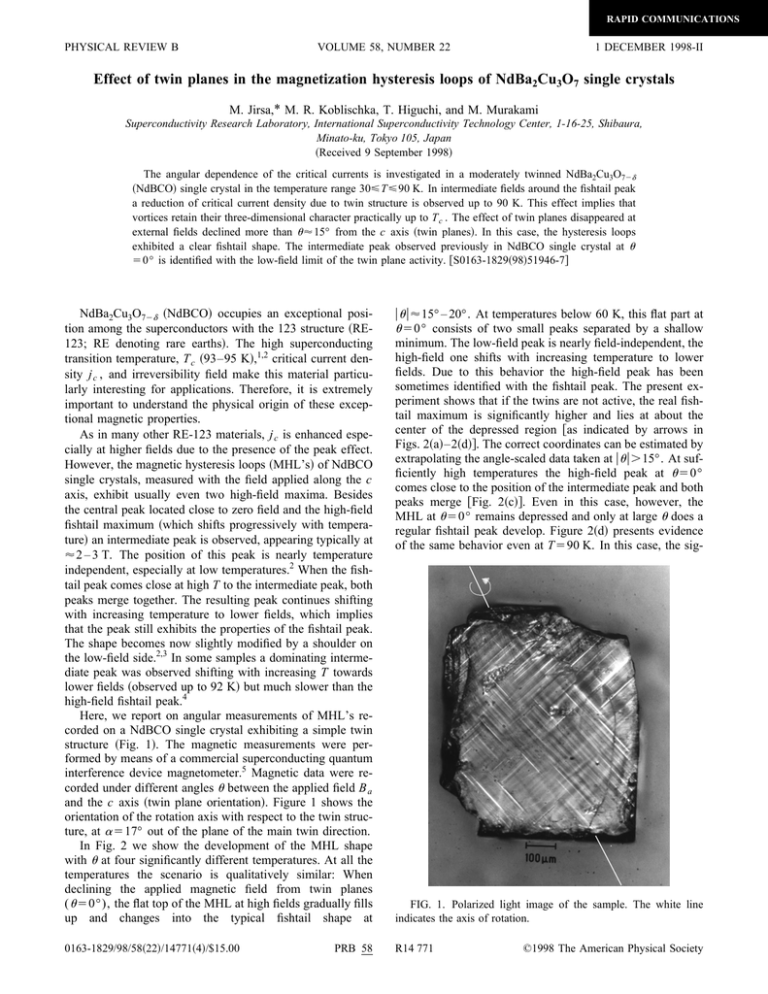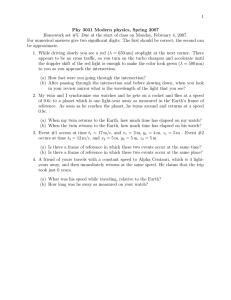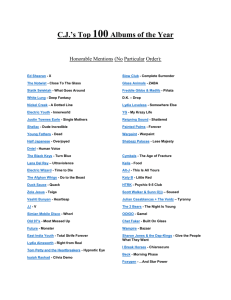Effect of twin planes in the magnetization hysteresis loops of... Cu O single crystals
advertisement

RAPID COMMUNICATIONS PHYSICAL REVIEW B VOLUME 58, NUMBER 22 1 DECEMBER 1998-II Effect of twin planes in the magnetization hysteresis loops of NdBa2Cu3O7 single crystals M. Jirsa,* M. R. Koblischka, T. Higuchi, and M. Murakami Superconductivity Research Laboratory, International Superconductivity Technology Center, 1-16-25, Shibaura, Minato-ku, Tokyo 105, Japan ~Received 9 September 1998! The angular dependence of the critical currents is investigated in a moderately twinned NdBa2Cu3O72d ~NdBCO! single crystal in the temperature range 30<T<90 K. In intermediate fields around the fishtail peak a reduction of critical current density due to twin structure is observed up to 90 K. This effect implies that vortices retain their three-dimensional character practically up to T c . The effect of twin planes disappeared at external fields declined more than u '15° from the c axis ~twin planes!. In this case, the hysteresis loops exhibited a clear fishtail shape. The intermediate peak observed previously in NdBCO single crystal at u 50° is identified with the low-field limit of the twin plane activity. @S0163-1829~98!51946-7# NdBa2Cu3O72d ~NdBCO! occupies an exceptional position among the superconductors with the 123 structure ~RE123; RE denoting rare earths!. The high superconducting transition temperature, T c ~93–95 K!,1,2 critical current density j c , and irreversibility field make this material particularly interesting for applications. Therefore, it is extremely important to understand the physical origin of these exceptional magnetic properties. As in many other RE-123 materials, j c is enhanced especially at higher fields due to the presence of the peak effect. However, the magnetic hysteresis loops ~MHL’s! of NdBCO single crystals, measured with the field applied along the c axis, exhibit usually even two high-field maxima. Besides the central peak located close to zero field and the high-field fishtail maximum ~which shifts progressively with temperature! an intermediate peak is observed, appearing typically at '2 – 3 T. The position of this peak is nearly temperature independent, especially at low temperatures.2 When the fishtail peak comes close at high T to the intermediate peak, both peaks merge together. The resulting peak continues shifting with increasing temperature to lower fields, which implies that the peak still exhibits the properties of the fishtail peak. The shape becomes now slightly modified by a shoulder on the low-field side.2,3 In some samples a dominating intermediate peak was observed shifting with increasing T towards lower fields ~observed up to 92 K! but much slower than the high-field fishtail peak.4 Here, we report on angular measurements of MHL’s recorded on a NdBCO single crystal exhibiting a simple twin structure ~Fig. 1!. The magnetic measurements were performed by means of a commercial superconducting quantum interference device magnetometer.5 Magnetic data were recorded under different angles u between the applied field B a and the c axis ~twin plane orientation!. Figure 1 shows the orientation of the rotation axis with respect to the twin structure, at a 517° out of the plane of the main twin direction. In Fig. 2 we show the development of the MHL shape with u at four significantly different temperatures. At all the temperatures the scenario is qualitatively similar: When declining the applied magnetic field from twin planes ( u 50°), the flat top of the MHL at high fields gradually fills up and changes into the typical fishtail shape at 0163-1829/98/58~22!/14771~4!/$15.00 PRB 58 u u u '15° – 20°. At temperatures below 60 K, this flat part at u 50° consists of two small peaks separated by a shallow minimum. The low-field peak is nearly field-independent, the high-field one shifts with increasing temperature to lower fields. Due to this behavior the high-field peak has been sometimes identified with the fishtail peak. The present experiment shows that if the twins are not active, the real fishtail maximum is significantly higher and lies at about the center of the depressed region @as indicated by arrows in Figs. 2~a!–2~d!#. The correct coordinates can be estimated by extrapolating the angle-scaled data taken at u u u .15°. At sufficiently high temperatures the high-field peak at u 50° comes close to the position of the intermediate peak and both peaks merge @Fig. 2~c!#. Even in this case, however, the MHL at u 50° remains depressed and only at large u does a regular fishtail peak develop. Figure 2~d! presents evidence of the same behavior even at T590 K. In this case, the sig- FIG. 1. Polarized light image of the sample. The white line indicates the axis of rotation. R14 771 ©1998 The American Physical Society RAPID COMMUNICATIONS R14 772 JIRSA, KOBLISCHKA, HIGUCHI, AND MURAKAMI PRB 58 FIG. 2. Magnetic hysteresis loops measured at different angles u between the applied field and c axis of the sample. ~a! 30 K, lower branch of MHL; ~b! 60 K, lower branch of MHL; ~c! 90 K. In the last case, the signal was quite low and the MHL was significantly distorted. nal was rather small and the MHL was strongly distorted by the paramagnetic contribution from Nd atoms. However, the basic features of the twin activity are still clearly visible. Figure 2 shows that the twin structure is active mainly in the field region around the fishtail maximum. Both below and above this region the MHL follows the fishtail shape. Figures 2~a! and 2~b! show that the intermediate peak observed at low u marks the onset of the twin structure activity. Oussena et al.6 and others3,4 argued that the reduction in critical currents at low u is due to channeling of vortices along twin planes, which results in a reduction of the internal field gradient, and, consequently, in a decrease of j c . Let us look closer at this effect. The pinning at twin planes is commonly expected to be stronger than the pinning on the pointlike noncorrelated pinning structure. This conclusion follows from the fact that the pinning efficiency of pinning sites is proportional to the effective pinning volume. In the case of a vortex inclined close to the twin plane, the pinning volume of the twin plane is naturally larger than that of even a group of disordered point defects. Twin boundaries present a serious obstacle for the flux movement, which is documented by magneto-optic ~MO! experiments at low fields. It was shown that magnetic flux propagates more easily along twin boundaries than across them,7 especially if the twin planes are oriented parallel or perpendicular to the edge of the sample. In this case the orientation of the twin ‘‘channels’’ coincides ~at least in one direction! with the natural way that magnetic flux penetrates the sample.8 On the other hand, for twin boundaries being declined from the orientation of the sample edges, no significant anisotropy in the flux entry has been observed. However, all these experiments show only the initial stage of the magnetization process. In the necessary temperature and field window, none of the present imaging techniques is effective.9 We can therefore only speculate how the vortices behave at high fields. It is natural to expect that they are pinned by all types of the present pinning sites, according to their effectivity. In the case of twin planes the pinning will become more effective when the angle u will be small and the projection of the vortex length onto the twin planes ~i.e., the effective pinning volume! will be large. If the twin plane pinning is more effective than that of the isotropic pinning disorder, why are the resulting critical currents not higher and why is just the opposite observed? It is quite difficult to understand why in a sample at the critical state a global redistribution of the flux pattern via twin channeling would start. The low values of relaxation rate observed in the field range of the MHL depression as well as the scaling of the depression field range with temperature speak against such interpretation. We suggest an alternative approach, in terms of critical current flow. The flux distribution in a sample with a randomly distributed isotropic pinning disorder is governed by the sample geometry. In a rectangular sample the critical currents flow preferentially along the sample edges @Fig. 3~a!#, so that a typical double-Y shape of the current discontinuity lines results. In a rectangular platelet they are usually oriented nearly diagonally, along ^110& and/or ^ 11̄0 & direc- RAPID COMMUNICATIONS PRB 58 EFFECT OF TWIN PLANES IN THE MAGNETIZATION . . . R14 773 FIG. 3. Schematic view of the critical current distribution in the case of the isotropic random pinning structure ~a! and a dominating twin plane pinning structure ~b!. In the first case, mainly geometry of the sample governs the current pattern; in the second case the pattern is controlled by the twin planes. In reality a mixed state is probably formed. tion. The twin structure introduces a strong in-plane anisotropy that should significantly change the current flow pattern, especially when vortices are close to the twin planes ~small u!. In the case of the ideal twin plane pinning and only one twin direction, the current flow pattern would be as depicted in Fig. 3~b!. Along twin planes vortices can move without large obstacles and therefore the field gradients in this direction and the associated currents would not probably differ much from those in Fig. 3~a!. However, on the narrower sides of the sample vortices meet the twin boundaries, their movement is significantly limited, and the area of the flux penetration in this direction is strongly reduced. This means that the field gradient in these regions ~normal to twin planes! and the corresponding current density ~along the twin boundaries! significantly increase. The current density, however, cannot exceed the limits set for the given temperature and field. This limit might result in limitation of the mean critical current value in the whole sample. The current patterns in the sample with and without twins are most probably quite different and the simple comparison of the corresponding total currents is not possible. In the case of twin planes declined from the sample edges ~the natural TB orientation is along ^110& and ^11̄0& directions!, the current distribution is probably more complex but the principle of the total current reduction should be the same. In real crystals, even more complicated patterns can be expected. The interpretation of the twin structure activity in terms of pinning instead of channeling is in agreement with the angular measurements, the low relaxation rate observed in the range of the twin activity, and the development of this process with temperature ~Fig. 2!. The field range, in which the suppression of critical currents is observed, as well as the position of this range scale with temperature in the same manner as the fishtail peak position. It is well known that the fishtail peak in general shifts with temperature in accord with the temperature change of irreversibility field, which is explained as a result of a thermal activation. We can conclude that the twin effect is also a thermally activated process and it is natural to suppose that the thermal activation enters via flux pinning. It is worth mentioning that both the character of the MHL depression and its angular dependence differ somewhat below and above the temperature where the secondary peaks FIG. 4. MHL’s measured at different angles u between the applied field and the c axis of the sample at 45 K. Note the asymmetrical development with respect to u 50 and the gradual development of the double peak structure. merge together ~in our sample '70 K, see Fig. 2!. The illustration of the behavior below '70 K is shown in Fig. 4 for T545 K: With external field inclining towards the twin planes, the MHL becomes more and more depressed and at u .26° a shallow minimum develops in the middle of the depression, separating two narrow secondary maxima. On further decrease of u, the minimum becomes deeper, up to u 50. On declining the field from the twin planes to the opposite side, the MHL depression as a whole decreases ~MHL height increases! but the two-peak structure remains unchanged up to about u .15.5°. Only above this angle the minimum fills up and the low-field maximum transforms into a shoulder on the ‘‘fishtail’’ peak. This shoulder disappears behind u .120°. Comparison of the curves for u .28.5° and u .15.5° or u .26.5° and u .13.5° shows the asymmetry of the angular dependence with respect to twin planes. At temperatures above 70 K, the MHL depression consists of only one high-field secondary peak and a shoulder on its low-field side. This shape of the depression does not significantly change with the angle, only the MHL height varies with u, becoming lowest at u 50. The angular dependence is nearly symmetric with respect to u 50. Note that in heavily twinned NdBCO single crystals the twin structure does not manifest itself in the above-described manner.10,11 In this case the in-plane anisotropy introduced by twin boundaries is probably so complicated that the geometry effect prevails and the complicated twin structure does not result in a significant statistical redistribution of currents. The twin plane pinning can be effective only for threedimensional ~3D! vortices. As the twin structure effect is observed in the whole temperature range up to 90 K, we can conclude that the vortices exist in the 3D state practically up to T c . The high-field limit for the effective twin plane activ- RAPID COMMUNICATIONS R14 774 JIRSA, KOBLISCHKA, HIGUCHI, AND MURAKAMI ity ~Fig. 2! might indicate the 3D-2D transition. This explanation is in accord with our observation that the critical current at high fields is only insignificantly increased after lock-in of vortices in the twin boundary structure. We note, however, that the experimental data in this field range are rather contradictory; e.g., Pradhan et al.11 found a significant increase of pinning due to twins in this range. The present angular experiments show that not only the intermediate peak observed at small u at low temperatures is due to twin pinning but also its high-field counterpart is strongly influenced by the twin structure activity. In the presence of twins, the height and position of the ‘‘true’’ fishtail peak have to be extrapolated from the angle scaled measurements in fields strongly declined from the twin planes. The intermediate peak is related to the start of the twin plane activity. The temperature independence of the position of this peak implies that some kind of matching effect can stay behind. The relevant pinning site distance should be around 35 nm. This value is close to the fine structure of twin planes as observed in Ref. 12. An alternative ‘‘matrix’’ for the matching effect might be the structure of the Nd-rich clusters that were shown to be just of the order of 30–35 nm.13 We note that at temperatures below 70 K a shoulder appears on the low-field side of the true fishtail @extrapolated from the angle-scaled measurements at large u ~Fig. 2!#. This shoulder lies approximately at the same field as the abovementioned start of the twin activity for low values of u. It is possible that at low temperatures the pinning strength of the twins is so large that they pin at least fragments of the vortices even outside the optimum angle range for the lock-in. *On leave from the Institute of Physics, ASCR, Na Slovance 2, CZ-182 21 Praha 8, Czech Republic. 1 M. Murakami et al., Jpn. J. Appl. Phys., Part 2 33, L715 ~1994!; S. I. Yoo et al., Appl. Phys. Lett. 65, 633 ~1994!. 2 M. R. Koblischka et al., Phys. Rev. B 54, R6893 ~1996!. 3 A. A. Zhukov et al., Phys. Rev. B 52, R9871 ~1995!. 4 Th. Wolf et al., Phys. Rev. B 56, 6308 ~1997!. 5 Quantum Design, San Diego, CA 92121, model MPMS7 equipped with a horizontal rotator. 6 M. Oussena et al., Phys. Rev. B 51, 1389 ~1995!. 7 V. K. Vlasko-Vlasov et al., Phys. Rev. Lett. 72, 3246 ~1993!; R. J. Wijngaarden et al., Phys. Rev. B 55, 3268 ~1997!. 8 M. R. Koblischka et al., Appl. Supercond. ~to be published!. PRB 58 Alternatively, this shoulder may be an evidence for the matching effect due to Nd-rich clusters.13 An independent support for this hypothesis is the fact that a similar shoulder is observed also in melt-textured samples of various RE-123 compounds containing Nd,14 where no intermediate peak has been observed so far. In conclusion, we found in the NdBCO single crystal a competition between pinning on twin planes and on an isotropic random pinning disorder. We suggest that the reduction of the critical current density around the fishtail peak is due to redistribution of the critical current pattern in the sample. Pinning on the twin planes is in this case decisive. This effect is observed up to 90 K, which indicates that vortices retain the 3D character up to temperatures close to T c . The reduction of critical currents scales with temperature in the same manner as the fishtail peak. This implies that similar thermally activated physical processes are causing both effects. The intermediate peak observed previously in NdBCO samples magnetized along c axis is identified with the start of the twin structure activity. The analysis shows that in the samples with a simple twin structure the actual fishtail peak position and size for small u have to be inferred from angle-scaled out-of-c-axis measurements. Otherwise, the identification of the secondary high-field peak on the depressed MHL with the fishtail peak leads to overestimation of the normalized pinning force at high fields. This work was partially supported by New Energy and Industrial Technology Development Organization ~NEDO! for the R & D of Industrial Science and Technology Frontier Program. M.J. and M.R.K. acknowledge support from STA. 9 The temperature and field range required here is currently out of range of all imaging techniques like magneto-optic imaging, Bitter decoration, micro Hall probes, Lorentz microscopy or scanning tunneling microscopy, see, e.g., M. R. Koblischka and R. J. Wijngaarden, Supercond. Sci. Technol. 8, 199 ~1995!. 10 T. Higuchi et al., Physica C 263, 396 ~1996!. 11 A. K. Pradhan et al., Phys. Rev. B 58, 9498 ~1998!. 12 M. Rand et al., Cryogenics 33, 291 ~1993!. 13 T. Egi et al., Appl. Phys. Lett. 67, 2406 ~1995!; N. Chikumoto, J. Yoshioka, and M. Murakami, Physica C 291, 79 ~1997!. 14 T. Mochida et al., Advances in Superconductivity IX ~Springer, Tokyo, 1996!, p. 519.





